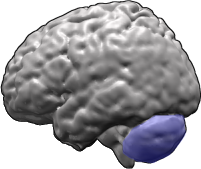Spinocerebellar ataxias
| Spinocerebellar ataxia | |
|---|---|
 |
|
| Cerebellum (in blue) of the human brain | |
| Classification and external resources | |
| Specialty | neurology |
| ICD-10 | G11.1 |
| ICD-9-CM | 334 |
| OMIM | 164400 |
| DiseasesDB | 12339 |
| MeSH | D020754 |
Spinocerebellar ataxia (SCA), also known as spinocerebellar atrophy or spinocerebellar degeneration, is a progressive, degenerative,genetic disease with multiple types, each of which could be considered a disease in its own right. An estimated 150,000 people in the United States have a diagnosis of spinocerebellar ataxia at any given time. SCA is hereditary, progressive, degenerative, and often fatal. There is no known effective treatment or cure. SCA can affect anyone of any age. The disease is caused by either a recessive or dominant gene. In many cases people are not aware that they carry a relevant gene until they have children who begin to show signs of having the disorder.
A few SCAs remain unspecified and can not be precisely diagnosed, but in the last decade genetic testing has allowed precise identification of dozens of different SCAs and more tests are being added each year. In 2008, a genetic ataxia blood test developed to test for 12 types of SCA, Friedreich's ataxia, and several others. However, since not every SCA has been genetically identified some SCAs are still diagnosed by neurological examination, which may include a physical exam, family history, MRI scanning of the brain and spine, and spinal tap.
Many SCAs below fall under the category of polyglutamine diseases, which are caused when a disease-associated protein (i.e., ataxin-1, ataxin-3, etc.) contains a large number of repeats of glutamine residues, termed a polyQ sequence or a "CAG trinucleotide repeat" disease for either the one-letter designation or codon for glutamine respectively. The threshold for symptoms in most forms of SCA is around 35, though for SCA3 it extends beyond 50. Most polyglutamine diseases are dominant due to the interactions of resulting polyQ tail.
The first ataxia gene was identified in 1993 and called "Spinocerebellar ataxia type 1" (SCA1); later genes were called SCA2, SCA3, etc. Usually, the "type" number of "SCA" refers to the order in which the gene was found. At this time, there are at least 29 different gene mutations that have been found.
The following is a list of some of the many types of Spinocerebellar ataxia.
Others include SCA18, SCA20, SCA21, SCA23, SCA26, SCA28, and SCA29.
...
Wikipedia
